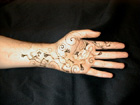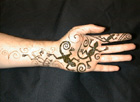|
Stage one of the application was to line up the design
on the recipient's hand. Using a soft eyeliner pencil I marked the
position of key elements. The henna was applied using a hand rolled
cone made with medium thickness polythene. The harder or thicker the
plastic used to make the cone, the greater degree of control can be
exerted over the line produced. The greater the control the more dead
or more sterile the line can appear. I try to be sensitive to the type
of art work I'm drawing, for example an Indian style application would
be better suited to a more fluid tool such as a carrot bag; conversely,
for tribal pieces I would use the hardest tip possible, e.g., a bottle.
The first henna lines were laid down before trimming the
tip of the cone. This gives an impossibly fine line and you must use
very well sifted henna. Using this super fine line the feet of the
lizards were drawn and outlines of the larger fill areas were placed.
After the entire design was roughed in with all the fine
detail in place the tip of the cone was cut to produce a heavier line
and the fine lines around the feet were filled in. At that stage the
body outlines were filled out, as well.
In the final stage the tip of the cone was cut again to
enable more rapid fill of the larger areas to be hennaed. A new fine
tipped cone was made up for the finishing touches and tidying up.
Aftercare
The design was applied in the evening and was protected with liquid
"newskin", latex and talc. The whole hand was further covered with a
tissue paper and cling film wrap, which was worn throughout the night
by the recipient. Photographed 24 hours after application the henna
appears lighter in the photo (Figure 4) than the original, true colour
of the henna. Further darkening continued for another 36 - 48 hours.
|





